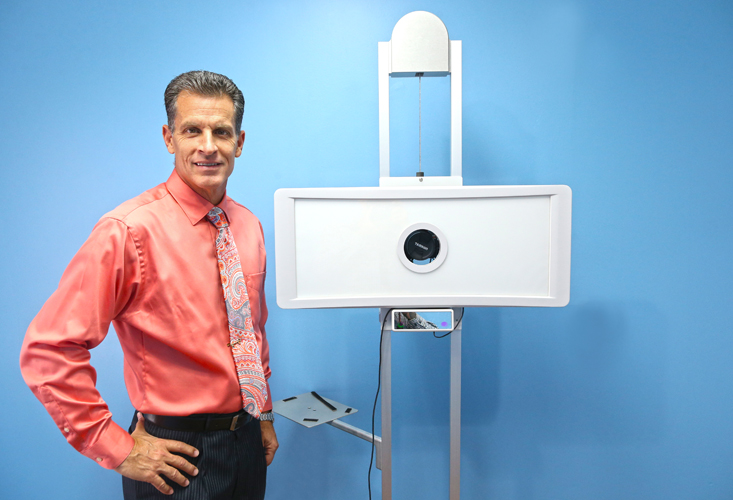
Diane Aldridge’s melanoma episode in 2007 woke her up to the realities of the potentially deadly cancer and the need to keep a sharp eye on her skin. She and her doctor now have a new tool for doing so.
“Once it happened to me, I wanted to make sure it didn’t happen again,” said Aldridge, 49, of Vero Beach, who was diagnosed with stage 1 melanoma, the least serious stage, after a mole in the shoulder area of her back was biopsied.
Twice-yearly visits to the dermatologist’s office are a must for her, and her vigilance now will include mole mapping, a technique new to this area. In a high-tech age, mole-mapping sounds commonsensically old school: Take pictures of the skin and compare them over time to see if anything changes in a worrisome way. The equipment, though, is decidedly cutting edge.
Her physician, Dr. Patrick Ottuso at Vero Beach Dermatology, recently purchased the system and begins using it later this month.
“It is exciting because it’s the same system they have at major hospitals across the country like Sloan Kettering in New York,” said Ottuso. “It’s a great thing for patients, documenting every spot on the skin so if anything new occurs,” steps can be taken. The process can help avoid needless biopsies in certain cases, as well.
In dermascopic imaging, close-up photos linked to special software are taken of the patient head to toe, excluding the genital area. A handheld extension permits examination of hard-to-see areas and the process altogether can look a bit into, not just at, the skin surface. “You can see things better than with the naked eye,” Dr. Ottuso said.
He sees patients with hundreds of moles and freckles on them. He tries to document everything he sees in an exam and keeps track of characteristics one year after another. But it’s not a foolproof method – there is no such thing.
The DermaGraphix digital mole-mapping system is meant to supplement traditional examinations and improve the odds of catching skin cancer early, which can make all the difference. Imaging adds to “an arsenal to detect melanoma at an early stage, when you can cure it,” he said.
“You can see a patient a year ago and it can be difficult to document every mole on the body and remember what they looked like. Now you have baseline imagery.”
Said Aldridge: “I’m excited about the equipment. It’s an extra set of eyes to make sure they don’t have any additional issues.”
The risks of excessive sun exposure are well known. But melanoma isn’t limited to years of blistering rays. “It can occur in places where the sun never shines,” Ottuso said, “so it’s important to have a thorough skin exam every year.” The cancer can be found on the bottom of feet, between toes, under toenails, in the mouth and other areas where it can be apt to go unnoticed.
One fallacy is that a mole smaller than an eraser head is of no concern. The doctor has seen problems in moles as small as one millimeter in diameter and melanoma can occur on previously clear skin, not always associated with a pre-existing mole or blemish. That said, moles and blemishes are harmless most of the time, so tracking them with imaging can bring peace of mind without having to biopsy every mark that might otherwise be taken off as a precaution or a test. This “minimizes the unnecessary excision of benign moles,” he says.
For doctors, the imaging system costs $12,000 to $20,000. For patients, it means wearing a bathing suit or underwear and having the pictures taken in a private studio next to the office. The visit usually lasts about 45 minutes.
For people age 35 and older at high risk – who have a history of melanoma and skin cancers – Ottuso recommends they be imaged every 3 years. And for those with chronic skin damage who are younger, every 5 years.
Melanoma accounts for less than 2% of skin cancer cases but causes a large majority of skin cancer deaths. According to the American Cancer Society’s estimates for melanoma in the United States for 2014, about 76,100 new melanomas will be diagnosed (about 43,890 in men and 32,210 in women). About 9,710 people are expected to die of melanoma (about 6,470 men and 3,240 women).
Aldridge becomes a bit anxious when it’s time for her twice-annual skin cancer checks. She was 42 when she was first diagnosed with melanoma and had to be under the care of an oncologist for a couple of years as a result.
“It’s nerve-wracking,” she said. Her scar is 3-4 inches. When she was a teenager she’d go to the beach with friends and wouldn’t think about sunscreen. “We’d hang out. Now I’m very cautious about using sunscreen.”



